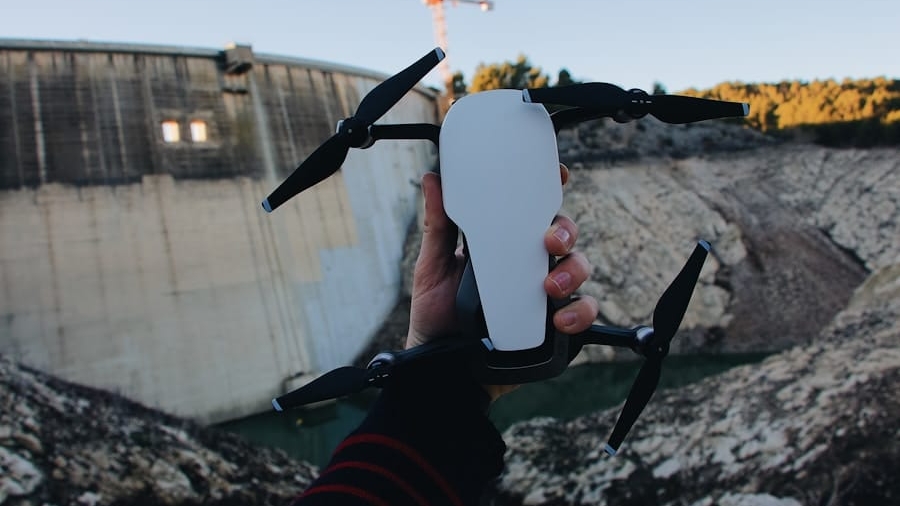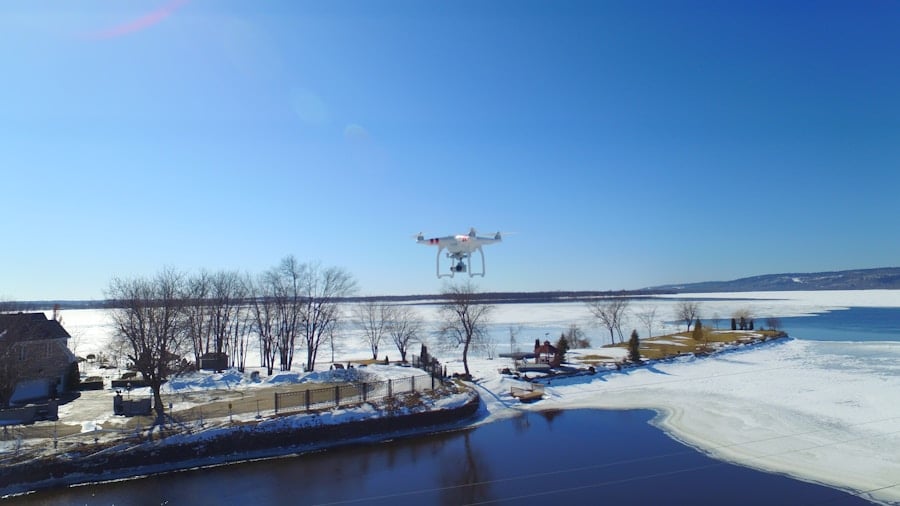The advent of drone technology has revolutionized various sectors, and infrastructure inspection is no exception. Drones, or unmanned aerial vehicles (UAVs), have emerged as a powerful tool for assessing the condition and integrity of critical infrastructure such as bridges, power lines, pipelines, and buildings. Traditionally, infrastructure inspection has relied on manual methods that often involve significant labor, time, and risk.
The integration of drones into this field not only enhances efficiency but also improves safety and data accuracy. By leveraging high-resolution cameras, thermal imaging, and LiDAR technology, drones can capture detailed images and data from angles and heights that would be challenging or impossible for human inspectors to reach. The use of drones in infrastructure inspection is particularly pertinent in an era where aging infrastructure poses significant challenges.
In many countries, bridges and roads are deteriorating, leading to safety concerns and costly repairs. Drones provide a means to conduct regular inspections without the need for extensive scaffolding or climbing equipment, thus minimizing disruption to traffic and reducing the risk of accidents. As the technology continues to evolve, the potential applications of drones in this field are expanding, paving the way for more proactive maintenance strategies and enhanced decision-making processes.
Key Takeaways
- Drones offer a cost-effective and efficient solution for infrastructure inspection, reducing the need for manual labor and improving safety.
- The use of drones in infrastructure inspection allows for access to hard-to-reach areas, reducing the risk to human inspectors and providing high-quality data.
- Challenges such as limited flight time, weather conditions, and data processing limitations need to be addressed for widespread adoption of drone-based infrastructure inspection.
- Current drone technology for infrastructure inspection includes advanced sensors, cameras, and software for data analysis, enabling detailed and accurate inspections.
- Innovations in drone-based infrastructure inspection include the use of artificial intelligence, machine learning, and autonomous flight capabilities, enhancing efficiency and accuracy.
Advantages of Using Drones for Infrastructure Inspection
One of the most significant advantages of employing drones for infrastructure inspection is the ability to conduct thorough assessments in a fraction of the time required by traditional methods. Drones can cover large areas quickly, capturing high-resolution images and videos that allow inspectors to identify potential issues with remarkable precision.
This efficiency not only saves time but also reduces labor costs associated with prolonged inspections. Moreover, drones enhance safety during inspections. Inspectors often face hazardous conditions when assessing infrastructure, such as working at great heights or navigating difficult terrain.
Drones eliminate the need for personnel to physically access dangerous locations, thereby significantly reducing the risk of accidents and injuries. For example, inspecting a wind turbine or a tall building can be perilous; however, a drone can easily fly to these heights and provide real-time data without putting human lives at risk. This shift not only protects workers but also allows for more frequent inspections, leading to better maintenance practices.
Challenges and Limitations of Drone-Based Infrastructure Inspection
Despite the numerous advantages that drones offer for infrastructure inspection, several challenges and limitations must be addressed. One primary concern is the regulatory landscape surrounding drone operations. In many regions, strict regulations govern where and how drones can be flown, particularly in urban areas or near critical infrastructure.
These regulations can limit the operational range of drones and may require special permits or licenses for commercial use. Navigating this complex regulatory environment can pose significant hurdles for companies looking to implement drone technology in their inspection processes. Another challenge lies in the technical limitations of drone technology itself.
While drones are equipped with advanced imaging systems, factors such as weather conditions can impact their performance. High winds, rain, or fog can hinder visibility and affect the quality of the data collected. Additionally, battery life remains a constraint; most commercial drones have limited flight times, which can restrict their ability to cover extensive areas in a single flight.
As a result, inspectors may need to plan multiple flights or invest in additional equipment to ensure comprehensive coverage during inspections.
Current State of Drone Technology for Infrastructure Inspection
The current state of drone technology for infrastructure inspection is characterized by rapid advancements in hardware and software capabilities. Modern drones are equipped with sophisticated sensors that enable them to capture high-resolution images, thermal data, and even 3D models of structures. For instance, LiDAR-equipped drones can create detailed topographical maps that are invaluable for assessing land use and planning maintenance activities.
These technological advancements have made it possible for inspectors to gather more accurate data than ever before. Furthermore, the integration of artificial intelligence (AI) into drone operations is transforming how data is analyzed and interpreted. AI algorithms can process vast amounts of imagery quickly, identifying anomalies or potential issues that may require further investigation.
This capability not only speeds up the inspection process but also enhances the accuracy of assessments by reducing human error. Companies are increasingly adopting these technologies to streamline their workflows and improve decision-making processes related to infrastructure maintenance.
Innovations and Developments in Drone-Based Infrastructure Inspection
Innovations in drone technology continue to emerge at a rapid pace, driving improvements in infrastructure inspection methodologies. One notable development is the use of autonomous drones that can operate without direct human control. These drones are programmed to follow predetermined flight paths and can conduct inspections on a schedule, allowing for regular monitoring of infrastructure without the need for constant oversight.
Another significant innovation is the advancement of sensor technology. Drones are now being equipped with multispectral cameras that can capture data beyond the visible spectrum, allowing inspectors to detect issues such as moisture intrusion or vegetation encroachment that may not be visible to the naked eye.
This capability is particularly beneficial for inspecting pipelines or power lines where early detection of potential problems can prevent costly failures or outages. As these technologies continue to evolve, they will further enhance the effectiveness of drone-based inspections.
Regulatory and Legal Considerations for Drone-Based Infrastructure Inspection
The regulatory framework governing drone operations is a critical aspect that influences the adoption of drone technology for infrastructure inspection. In many countries, aviation authorities have established guidelines that dictate how drones can be used commercially. These regulations often include restrictions on flight altitude, no-fly zones near airports or populated areas, and requirements for pilot certification.
Compliance with these regulations is essential for companies seeking to utilize drones for infrastructure inspections legally. Additionally, privacy concerns play a significant role in shaping drone regulations. The ability of drones to capture high-resolution images raises questions about surveillance and data protection.
Companies must navigate these legal considerations carefully to ensure they respect individuals’ privacy rights while conducting inspections. This often involves obtaining necessary permissions from property owners or stakeholders before flying drones over specific areas.
Future Applications and Potential Impact of Drone-Based Infrastructure Inspection
Looking ahead, the future applications of drone-based infrastructure inspection are vast and promising. As technology continues to advance, we can expect drones to play an increasingly integral role in smart city initiatives. For example, drones could be used in conjunction with IoT (Internet of Things) devices to monitor infrastructure health in real-time, providing immediate alerts when issues arise.
This proactive approach could lead to more efficient maintenance strategies and reduced downtime for critical services. Moreover, the integration of drone technology with machine learning algorithms holds great potential for predictive maintenance. By analyzing historical data collected from inspections over time, AI systems could identify patterns that indicate when infrastructure components are likely to fail.
This predictive capability would allow organizations to address issues before they escalate into costly repairs or safety hazards, ultimately extending the lifespan of infrastructure assets.
The Role of Drones in Shaping the Future of Infrastructure Inspection
As we move forward into an era defined by technological innovation, drones are poised to play a transformative role in infrastructure inspection practices worldwide. Their ability to enhance efficiency, improve safety, and provide high-quality data positions them as indispensable tools for engineers and inspectors alike. While challenges remain—particularly regarding regulations and technical limitations—the ongoing advancements in drone technology promise to overcome these hurdles.
The future landscape of infrastructure inspection will likely see an increased reliance on drones as organizations seek more effective ways to manage their assets. With innovations such as autonomous flight capabilities and advanced sensor technologies on the horizon, the potential impact of drone-based inspections will only grow more significant over time. As industries adapt to these changes, we can anticipate a shift toward more sustainable practices that prioritize safety and efficiency in maintaining our critical infrastructure systems.
In a related article titled How One Founder Realized the Potential of Sustainable Energy, the focus shifts to the innovative ways in which entrepreneurs are harnessing sustainable energy sources to create a more environmentally friendly future. This article explores the journey of a founder who recognized the importance of sustainable energy and successfully implemented it into their business model. Just like the advancements in drone technology are revolutionizing infrastructure inspection, sustainable energy solutions are reshaping the way we power our world.
FAQs
What is drone-based infrastructure inspection?
Drone-based infrastructure inspection involves using unmanned aerial vehicles (UAVs) equipped with cameras and sensors to inspect and monitor infrastructure such as bridges, buildings, power lines, and pipelines.
What are the benefits of using drones for infrastructure inspection?
Using drones for infrastructure inspection offers several benefits, including cost savings, improved safety for inspectors, faster data collection, and the ability to access hard-to-reach or hazardous areas.
How are drones used for infrastructure inspection?
Drones are equipped with high-resolution cameras, LiDAR sensors, thermal imaging, and other specialized equipment to capture detailed images and data of infrastructure. This data is then analyzed to assess the condition of the infrastructure and identify any potential issues.
What are the challenges of using drones for infrastructure inspection?
Challenges of using drones for infrastructure inspection include regulatory restrictions, privacy concerns, limited flight time and range, and the need for skilled operators and data analysts.
What is the future of drone-based infrastructure inspection?
The future of drone-based infrastructure inspection is expected to involve advancements in drone technology, such as longer flight times, improved sensors, and autonomous flight capabilities. Additionally, the use of artificial intelligence and machine learning for data analysis is likely to play a significant role in the future of drone-based infrastructure inspection.



